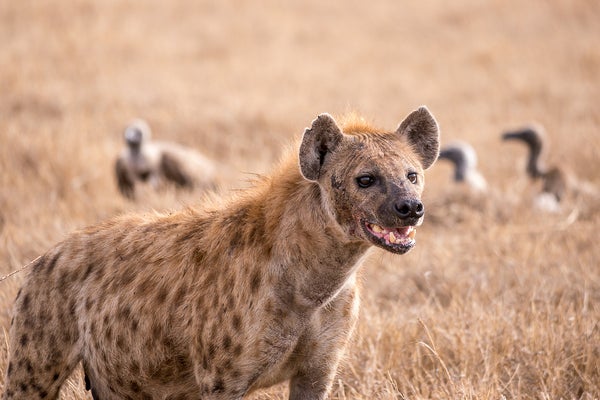Physical similarities aside, we share a lot in common with our primate relatives. For example, as Jane Goodall famously documented, chimpanzees form lifelong bonds and show affection in much the same way as humans. Chimps can also solve novel problems, use objects as tools, and may possess “theory of mind”—an understanding that others may have different perspectives than oneself. They can even outperform humans in certain types of cognitive tasks.
These commonalities may not seem all that surprising given what we now know from the field of comparative genomics: We share nearly all of our DNA with chimpanzees and other primates. However, social and cognitive complexity is not unique to our closest evolutionary cousins. In fact, it is abundant in species with which we would seem to have very little in common—like the spotted hyena.
For more than three decades, the Michigan State University zoologist Kay Holekamp has studied the habits of the spotted hyena in Kenya’s Masai Mara National Reserve, once spending five years straight living in a tent among her oft-maligned subjects. One of the world’s longest-running studies of a wild mammal, this landmark project has revealed that spotted hyenas not only have social groups as complex as those of many primates, but are also capable of some of the same types of problem solving.
On supporting science journalism
If you're enjoying this article, consider supporting our award-winning journalism by subscribing. By purchasing a subscription you are helping to ensure the future of impactful stories about the discoveries and ideas shaping our world today.
This research sheds light on one of science’s greatest mysteries—how intelligence has evolved across the animal kingdom. According to the social brain hypothesis, intelligence has evolved to meet the demands of social life. The subject of many popular articles and books, this hypothesis posits that the complex information processing that goes along with coexisting with members of one’s own species—forming coalitions, settling disputes, trying to outwit each other, and so on—selects for larger brains and greater intelligence. By contrast, the cognitive buffer hypothesis holds that intelligence emerges as an adaption to dealing with novelty in the environment, in whatever form it presents itself.
The social brain hypothesis is well-supported in research on primates: The more social a primate species, the bigger its brain and the smarter it tends to be. However, Holekamp’s work challenges this hypothesis as a general explanation for the evolution of intelligence. In a 2012 study carried out in the Masai Mara reserve, Holekamp and former graduate student Sarah Benson-Amram devised a “puzzle box” to measure hyenas’ ability to innovate—that is, to solve a problem they had never before encountered. In each trial, a piece of raw meat was placed in the puzzle box, and the hyena’s task was to slide a latch, and then to swing open a door to get the food. Across 62 hyenas, the best predictor of success was what might be considered an adaption to dealing with novelty in the environment—exploratory behavior. Hyenas that employed a range of different behaviors in the first trial to size up the puzzle box were ultimately more likely to figure out how to open it than their less curious counterparts. On the other hand, there was no correlation between social rank and success.
More recently, in a study published in the Proceedings of the National Academy of Sciences, Benson-Amram, Holekamp, and colleagues used the puzzle-box paradigm to test innovation ability in 140 zoo-dwelling animals representing 39 species of mammalian carnivore, from the polar bear to the snow leopard to the fennec fox. Controlling for body mass, brain size predicted percentage of successful trials (bigger brain, better performance). However, there was no correlation between the average group size for the animals and success. In fact, despite their solitary nature, bears were the most adept at opening the puzzle box. By contrast, the highly social mongooses, who live in “mobs” with an average size of nearly 30, were among the worst performers. While not necessarily ruling out the social brain hypothesis, these findings provide support for the cognitive buffer hypothesis. In future work, Holekamp and colleagues plan to more directly test the cognitive buffer hypothesis by comparing the innovation ability of hyenas living in wild versus urban environments.
So, the story of how intelligence has evolved across the animal kingdom is likely complex. Intelligence may have evolved in one way in primates, but in other ways in carnivores and other animals. With extinctions occurring across the animal kingdom at a rate estimated to be a thousand times greater than the natural rate, research like Kay Holekamp’s groundbreaking study of the spotted hyena is all the more urgent to fill in the missing pieces of this puzzle.

